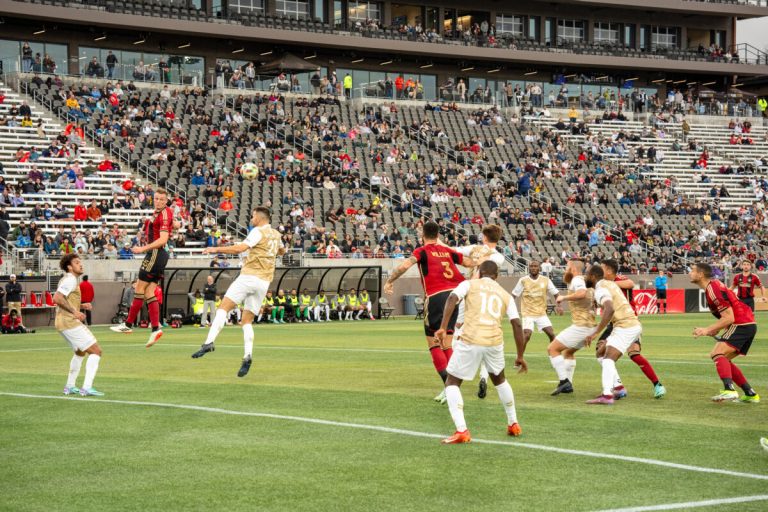10 sports analytics insights from ESPN’s Ben Alamar at Sloss Sport 2018
Reading time: 5 minutes

How does big data change the way we watch, play, coach and work in sports? Ben Alamar, ESPN director of sports analytics, addressed that question Thursday during his keynote speech at Sloss Sport 2018, hosted by Knight Eady at Regions Field on Thursday. Part of Birmingham Innovation Week, the inaugural conference welcomed 200 attendees from across the Southeast.

1. Sports analytics is not a strategy; it’s a new set of tools.
Analytics saves time and provides better information to management and coaches, helping them formulate better strategies. The improved tool set includes:
- Data management: Every stat about player’s salary, health and performance is centralized.
- Predictive analytics: We’re crunching more data than ever and at lightning speeds.
- Information systems: We can access info anywhere via smartphones, laptops and tablets.

2. We can record where everything is on the field or court 25 times a second.
Holy moly! For 1 minute, that’s 1,500 sets of data.
The recording method may be optic tracking or chips placed in balls and on the players’ clothing, such as in a football player’s shoulder pads. Beyond box scores and play-by-play data, we know how everyone contributed to every moment—and we can access that data anytime.
If it were up to humans to analyze all that data, it would be impossible. With today’s technology, what used to take months of analysis now takes minutes.
3. Analysis leads to better coaching and better player decisions.
A basketball player has the chance to make a shot from the rim. He chooses to make a pass, setting up the game-winning shot. Did the player made a good decision or a bad one?

If we only look at the outcome, we may say the player made a good decision by passing. The team won, after all.
However, if we crunch the numbers, the data may reveal that particular player had a higher chance of making the shot from the rim.
For more wins long-term, a coach can use such insights to train players to make the best decision in any given circumstance.
4. The teams who use sports analytics have a serious edge.
In 2008, the Seattle Supersonics picked Russell Westbrook as a 4th-round NBA draft pick, and we could hardly wrap our human brains around the logic. Look at Westbook today, a seven-time NBA All-Star, and the decision seems incredibly prescient.
That’s the power of predictive analytics in sports. During the 2008 NBA draft, Supersonics leadership knew Westbook’s skills as point guard were on par with the best in the NBA, even though he did not play the position in college.

Twenty-six out of 31 teams in the NBA invest big money in analytics. Those precious predictions requires AI, advanced analysis tools and people with PhDs in the field. It would be gibberish otherwise.
The four teams who haven’t invested? None of them made the playoffs, Alamar said.
5. The million dollar question: Does the “hot hand” exist?
The debate is ongoing, Alamar said. But here’s what he does know:
- Stat 1: Players act differently when they believe they’re hot.
- Stat 2: Defenses act differently when they believe a player is hot, and they make bad decisions.
- Stat 3: Offenses are better off taking advantage of opponents’ impaired decision making during the “hot hand” phenomenon.
Best decision: Don’t feed the hot hand, even if it’s real.
Sloss Sport 2018 attendees from Birmingham City Schools can take valuable bits of wisdom like that back to our home teams!

6. Journalists can use sports analytics to tell better stories.
LeBron James just made an incredible cross court pass to the 3-point line. Could any other player have made that pass?
With big data and analytics, journalists can ask questions like that, get the answer and use it to tell a unique story, Alamar said.

7. Sports analytics doesn’t take the heart out of the game.
Alamar’s own grandfather has accused him of “sucking all the joy” out of sports. But he promises that’s not what sports analytics is about. It’s about better coaching, better decision making in the heat of the moment and better games.
“It has to be instinct for the players. They’re making 3- or 4-second decisions. It’s about drilling, so they are not thinking about it by the time they get into the game. You don’t want them thinking about percentages.”—Ben Alamar, ESPN director of sports analytics, Sloss Sport 2018
8. How do different sports stack up?
This question isn’t about the superiority of one sport over another; it’s about the complexity of the data involved. From least complicated data to most, here’s how Alamar ranks four sports:
- Baseball: 90 percent of data between 2 players
- Basketball: 10 players, continuous movement
- American football: 22 players, movements not continuous, but also not predictable
- Soccer: lots of players, continuous movement, few key events to hang onto
9. It all comes down to leadership.
All the predictive analytics in the world won’t change strategy unless coaches, managers and owners take it seriously.
On the other hand, Alamar said, analysts have to make good arguments, build trust and form personal relationships with decision makers. Building openness to big data takes time.
10. A customized highlight reel could be in your future.
It’s good to be a fan these days, isn’t it!


![Georgia Southern beats App State in JLab Birmingham Bowl [PHOTOS] Georgia Southern beats App State in JLab Birmingham Bowl [PHOTOS]](https://wp.fifu.app/bhamnow.com/aHR0cHM6Ly9iaGFtbm93LmNvbS93cC1jb250ZW50L3VwbG9hZHMvMjAyNS8xMi9iaXJtaW5naGFtYm93bC0zLXNjYWxlZC1lMTc2NzEyMzczMzc0My0xMjAweDYyOC5qcGc/00bfb8674b64/georgia-southern-beats-app-state-in-jlab-birmingham-bowl-photos.webp?w=768&h=0&c=0&p=1579627)
